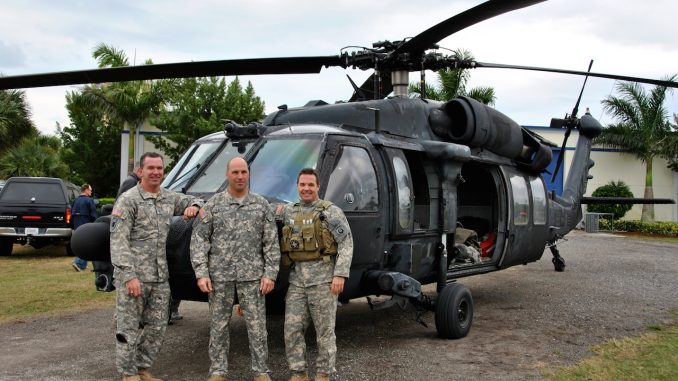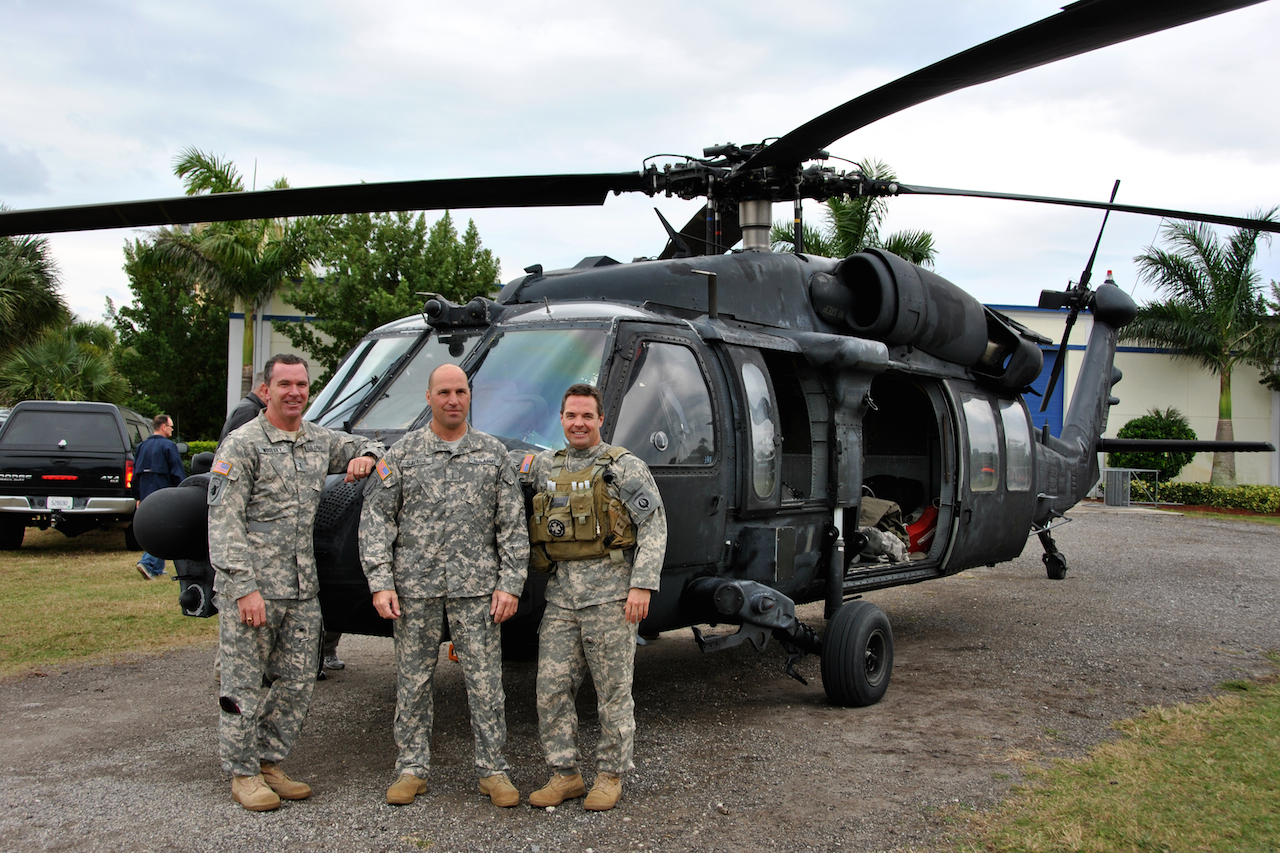

PRESS RELEASE – FORT PIERCE, Fla. – As the crowd gathered around the National Navy Sea, Air and Land (SEAL) Museum Nov. 19, 2014, it became clear this wasn’t a standard military retirement. There was no podium, no colors and no sound system. A small crowd gathered with their eyes fixed on the horizon.Then, a familiar sound became increasingly audible to the special operators in attendance. That sound was the rotors of two MH-60 Black Hawks, a MH-60K and a MH-60L, as they appeared over the shoreline, flying as a team one final time.
The MH-60K, tail number 388, made it’s long anticipated final flight from Fort Campbell, Ky. to the National SEAL Museum, where it will be demilitarized and put on display.“The relationship between the Army, the Navy and what we do has been in the shadow for a long time,” said Rick Kaiser, a retired Navy Seal Master Chief Petty Officer and Executive Director of the museum. “A lot of people will ask the same question – ‘Why do you have this Black Hawk in here?’ People always assume it’s Navy aircraft that fly the SEALs around. We will then be able to tell them the story about the relationship between the SEALs and the Army Special Operations Aviators.”
The process, which began almost a year prior, required careful coordination between several command elements, branches and offices across the Army; the unit who owned the aircraft – 1st Battalion, 160th Special Operations Aviation Regiment (Airborne) (SOAR) (A), 160th SOAR (A) Operations Section, The United States Army Special Operations Aviation Command (Airborne) (USASOAC) (A) Aviation Readiness Branch, the USASAOC (A) Technology Applications and Program Office, the SEAL Museum, and the Army Tank and Automotive Command (TACOM) donations branch. All offices worked together to ensure all the necessary requirements were met in order to legally transfer the aircraft to the museum.
Sgt. 1st Class Joseph W. Evans, USASOAC (A) Aviation Readiness Branch Senior Maintenance Noncommissioned Officer in Charge, has been working the project since he arrived to the unit in March.“This is the first time I have had the opportunity to work an aircraft donation for the team,” said Evans. “Previously, I worked with the U.S. Army Center of Military History to divest aircraft [tail number] 288 to the U.S. Army Aviation Museum at Fort Rucker, Ala. There is a big difference between a divesture and an outright donation to a group not funded by the Federal Government.”
For the aircraft 388’s final flight, it only seemed fitting that Chief Warrant Officer 5 Ben D. Savage, 160th SOAR’s (A) Command Chief Warrant Officer, was in the cockpit. Savage has been training on the airframe since it arrived in the unit 20 years ago.“We started getting the MH-60K in 1994,” he said. “I was part of the train-the-trainer in Block Zero. Block Zero was to train all the instructor pilots in each of the following blocks. In April of ’94 I got qualified on the aircraft and started teaching block one in the fall.”
Savage, who had close to 4000 flight hours on the MH-60K airframe, said tail number 388 had a storied history during its lifetime.“This aircraft has been on multiple Joint Readiness Exercises leading up to 2001,” he explained. “It has also been in a “Class A” accident where it rolled over and was unable to fly for an extended period of time. In 2002, it made its first trip to Afghanistan and has flown multiple missions in Iraq, Afghanistan and Africa since that time. During one of 388’s missions, the aircraft’s copilot had his microphone boom shot off his helmet and its pilot-in-command was shot in the face. They still managed to fly the aircraft out of the area after it had taken fire, so the aircraft has a significant history of battle damage as well.”
The aircraft also participated in the mission that helped rescue American, Jessica Buchanan and her coworker, Poul Hagen Thisted. Both Buchanan and Hagen Thisted were captured by Somalian pirates and held hostage for three months in 2012.During the operation, SEAL team members parachuted into the objective and engaged the pirates, killing all of them. After the firefight, multiple aircraft evacuated the SEALs and the two hostages, including aircraft 388.“I’m going to put this on my list of things to do once this display gets set up,” Savage said. “We are leaving our checklists, which have our names in them, in the aircraft. So it’s an honor to know it’s going to be in the SEAL Museum. It’s quite fitting because of the number of SEALs we’ve carried around in this airframe.”
As for Evans, he said everyone’s hard work to get the aircraft donated to the museum pales in comparison to what the pilots, crew members and MH-60K have all given to the Special Operations community.“To me, the reward is knowing the 160th’s last MH-60K will be preserved and on display for many years to come,” he said. “This ensures the memory of those that have gone before us and what they accomplished on so many missions with the use of the MH-60K and more specifically, aircraft 388.”
Story by Sgt. 1st Class Thaddius Dawkins



I am proud to have retired from the SOFSA who made the mods on the K,L, and the Mike models in Lexington.